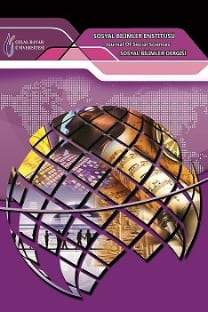PERCEPTION OF NATURE AND THE LANGUAGE OF IMPERIALISM IN RUDYARD KIPLING’S THE JUNGLE BOOK
Rudyard Kipling, The Mowgli Stories, imperialism, binary of man and nature
___
- ADAMS, Carol J (2003), The Pornography of Meat, Continuum, New York. ARMSTRONG, Philip (2011), “The Gaze of Animals,” Theorizing Animals: Re-thinking Humanimal Relations, (eds.) Nik Taylor and Tania Signal, Brill, Leiden and Boston, ss. 175-202. BEATSON, Peter (2011), “Mapping Human Animal Relations.” Theorizing Animals: Re-thinking Humanimal Relations, (eds.) Nik Taylor and Tania Signal, Brill, Leiden and Boston, ss. 21-58. BERGER, John (1991), “Why look at Animals? About Looking, Vintage, New York. DELUZE, Gilles and Felix GUATTARİ (1983), Anti-Oedipus, (trans.) Robert Hurley, Mark Seem and Helen R. Lane, U of Minneapolis P, Minneapolis. DERRIDA, Jacques (2002), “The Animal That Therefore I Am,” Critical Inquiry 28.2, ss. 369-418. GÖKÇEN, Nilsen (2015), Encountering the Animal: Explorations in American Literature, Boyut, Ankara. FOUCAULT, M (2008), The History of Sexuality Volume 1 (1976). Penguin, Camberwell, Victoria. HARAWAY, Donna (2006), “Encounters with Companion Species: Entangling Dogs, Baboons, Philosophers, and Biologists,” Configurations 14.1.2, ss. 94-114. KEMMERER, Lisa (2011), “Theorizing Others.” Theorizing Animals: Re-thinking Humanimal Relations. (eds.) Nik Taylor and Tania Signal, Brill, Leiden and Boston, ll, ss. 59-84. KIPLING, Rudyard (2016), The Jungle Book, Macmillan, London. NATH, Dipika (2009), “ ‘To Abandon the Colonial Animal’: ‘Race,’ Animals and the Feral Child in Kipling’s Mowgli Stories,” Animals and Agency: An Interdisciplinaty Exploration, (eds.) Sarah H McFarland and Ryan Hediger, Brill, Leiden and Boston, ss. 251-278. PUGLIESE, Joseph (2017), “Terminal Truths: Foucault’s Animals and the Mask of the Beast,” Foucault and Animals, (eds.) Matthew Chrulew and Dinesh Joseph Wadiwel, Brill, Leiden and Boston, ss. 19-36. SAVAGE-RUMBAUGH, Sue (2004), Kanzi: The Ape at the Brink of the Human Mind, John Wiley and Sons, New Jersey. SZARYCS, Gregory S. (2011), “The Representations of Animal Actors: Theorizing Performance and Performativity in the Animal Kingdom,” Theorizing Animals: Re-Thinking Humanimal Relations, (eds.) Nik Taylor and Tania Signal, Brill, Leiden and Boston, ss. 149-174. WEIL, Kari (2012), Thinking Animals, Columbia UP, New York.
- ISSN: 1304-4796
- Yayın Aralığı: Yılda 4 Sayı
- Başlangıç: 2003
- Yayıncı: Manisa Celal Bayar Üniversitesi
CENGİZ AYTMATOV'UN DİŞİ KURDUN RÜYALARI ROMANINDA ÇEVRE FELAKETİ
TOXIC EFFECTS OF NEONICOTINOID INSECTICIDES ON NON-TARGET ORGANISMS
MANİSA ATMOSFERİNDE ÖNEMLİ ALLERJENİK POLENLER
Aykut GÜVENSEN, Ulaş UĞUZ, Ece BULUŞ, Nedret ŞENGONCA TORT, Aylin EŞİZ DEREBOYLU, Levent ŞIK
CENGİZ AYTMATOV’UN HİKÂYE VE ROMANLARINDA ÇEVRE DUYARLILIĞI
NATURAL RADIOACTIVITY OF THE COASTLINE OF ÇEŞME-İZMİR ABSTRACT
UPTAKE OF SOME NON-ESSENTIAL METALS BY THE ALGA CHLORELLA VULGARIS ABSTRACT
ÇERNOBİL DUASI”NDA, ANLATI KAHRAMANLARININ FELAKET KARŞISINDAKİ GERÇEK/GERÇEKÜSTÜ TUTUMLARI
BIOLOGICAL TREATMENT OF SOME ESSENTIAL METALS BY USING CHLORELLA VULGARIS
PERCEPTION OF NATURE AND THE LANGUAGE OF IMPERIALISM IN RUDYARD KIPLING’S THE JUNGLE BOOK
